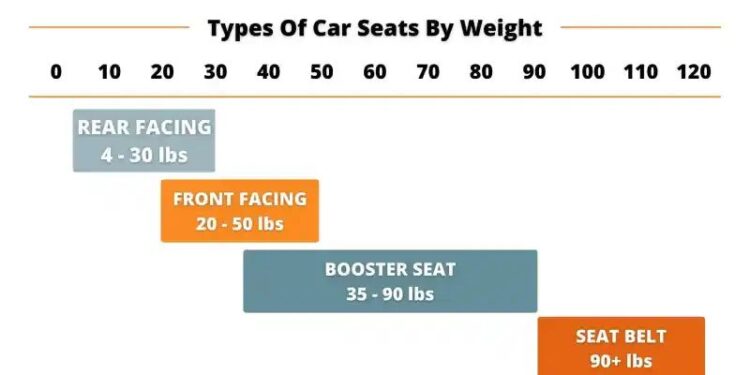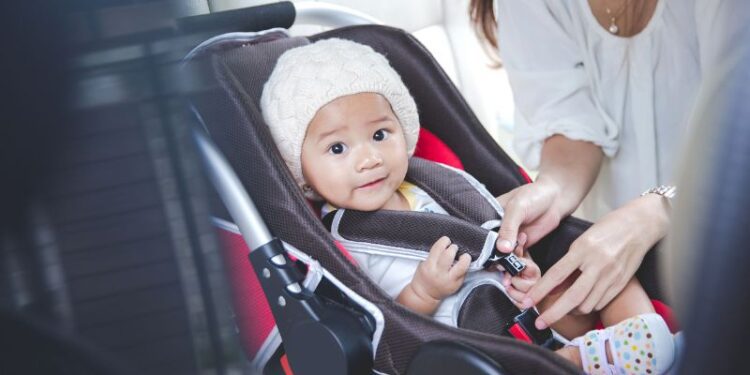Vehicle seat wellbeing is a central worry for guardians and parental figures, and it assumes a vital part in safeguarding kids during vehicle ventures. In order to guarantee the safety and well-being of young passengers, Indiana, like many other states in the United States, has specific laws and requirements for car seats. In this article, we will dive into Indiana Car Seat Laws and Requirements for Height and Weight in 2023
Indiana Car Seat Laws and Requirements for Height and Weight in 2023
Car seat laws are in place to protect children and lower the likelihood of injuries or deaths in car accidents. Engine vehicle mishaps are a main source of youngster fatalities, and appropriately utilized vehicle situates essentially decline the possibilities of serious wounds. To ensure the safety of their children while driving, parents and caregivers must be aware of and adhere to car seat laws.
Indiana’s Car Seat Laws
The laws governing car seats in Indiana are intended to address the various developmental stages of children and the particular safety requirements they have. When deciding which kind of car seat is best for a child’s age, height, and weight at each stage, the law takes these factors into account. It is essential to keep track of the most recent requirements because these laws are subject to change.
Rear-Facing Car Seats
The first step in ensuring a child’s safety while driving is installing a rear-facing car seat. By cradling their fragile bodies and providing support for their developing neck and spine, they provide essential protection for infants and young toddlers.
Benefits of Rear-Facing Car Seats
Rear-facing car seats provide a number of advantages, including the following:
Better safeguards for the spine, neck, and head in the event of a collision.
- Absorbing the entire impact of a collision across the seat’s back.
- Decreased danger of injuries to the head and neck.
- Ensuring that the child is in a safe position.
Age and Weight Prerequisites
In Indiana, the law specifies that youngsters should stay in a back confronting vehicle seat until the age of 2 or until they arrive at the level and weight limits determined by the vehicle seat maker. To ensure maximum safety for your child, it is essential to adhere to the manufacturer’s weight and height restrictions for the car seat. The transition to a forward-facing seat should not be rushed, and your child’s safety should come first.
Forward-Facing Car Seats
When a child has outgrown the rear-facing car seat, it’s time to move on to the forward-facing one. Children will continue to get support and protection from these seats as they get older.
Advantages of Forward-Facing Car Seats
Forward-Facing Car Seats offer a few benefits, for example,
- Upgraded assurance for the chest area, including the head and middle.
- Harness systems that distribute crash forces to the body’s strongest areas.
- Features that can be changed to fit a child’s changing needs.
- Weight and height restrictions are higher than in rear-facing seats.
Age and Weight Necessities
As per Indiana vehicle seat regulations, kids ought to stay in a front aligned vehicle seat until they arrive at the age of 4 or meet the level and weight limits set by the vehicle seat producer. Before switching to a booster seat, it is highly recommended to use a car seat with a harness for as long as possible.
Booster Seats
Sponsor seats are the following stage in vehicle seat security for more established kids who have grown out of front aligned situates yet are not yet prepared to utilize safety belts alone. These seats raise kids to a level where the safety belt fits them appropriately.
Benefits of Booster Seats
Supporter seats offer a few advantages, including:
- The child’s seat belt should be properly positioned across their body.
- Expanded security and diminished hazard of injury in case of an impact.
- Comfort for longer car rides.
- Supplementary assistance for the child’s growing body structure.
Requirements for Age and Height
In Indiana, children should use a booster seat until they are at least 8 years old or 4 feet 9 inches tall. It is essential to check that the seat belt fits correctly, with the shoulder belt resting on the chest and shoulder rather than the neck or face and the lap belt snugly covering the upper thighs.

Seat Belt Use
When a youngster has grown out of the requirement for a sponsor seat, they can progress to utilizing a safety belt alone. However, for optimal safety, it is essential to check that the seat belt fits correctly.
Transitioning from Booster Seats to Seat Belts
When making the switch from a booster seat to a seat belt, a number of things need to be taken into account, including the age, height, and level of maturity of the child. In order to determine whether a child is ready to use a seat belt alone, the “5-Step Test” should be performed.
Age and Height Requirements
Indiana vehicle seat regulations expect youngsters to utilize a promoter seat until they arrive at the age of 8 or until they are sufficiently tall to appropriately utilize a safety belt. The shoulder belt should rest on the shoulder and chest without crossing the neck or face, and the seat belt should fit snugly across the upper thighs.
Exceptions to the Law
There are some exceptions to the Indiana car seat laws, such as medical exemptions or situations in which the vehicle does not provide an appropriate seating position with a seat belt. However, in order to determine whether an exception applies to your circumstance, it is essential to consult the specific regulations and requirements.
Understanding Car Seat Safety
To guarantee the most elevated level of vehicle seat wellbeing, it is pivotal to comprehend the essentials of vehicle seat establishment, use, and upkeep. This includes understanding the various kinds of car seats, how to properly harness a child, and staying up to date on the most recent safety recommendations and guidelines. Choosing the right car seat is important for keeping your child safe while driving. When selecting a car seat, a child’s age, weight, and height, as well as the specific requirements outlined by Indiana car seat laws, are all important considerations.
Installing Car Seats Correctly
To be effective, car seats must be installed correctly. To ensure proper installation, it is essential to carefully read the instructions provided by the car seat manufacturer and the owner’s manual for the vehicle. If you follow the instructions provided by experts and, if necessary, seek professional assistance, you can help ensure that the car seat is installed securely and positioned correctly.
Maintaining Car Seat Safety
Vehicle seats require standard support to guarantee ideal security. It’s critical to direct routine checks to guarantee that the seat is liberated from harm or imperfections. Also, keeping the vehicle seat clean and supplanting it after a mishap or arriving at its termination date is fundamental for keeping up with its adequacy.
FAQs about Indiana Car Seat Laws and Requirements for Height and Weight in 2023
Might I at any point utilize a recycled vehicle seat for my youngster?
Utilizing a used car seat is generally not recommended, despite the temptation. The safety of car seats is at risk because they have an expiration date and may have been used. Moreover, a recycled vehicle seat might need significant security includes or have been engaged with a mishap, making it less dependable.
Are vehicle seat regulations the equivalent across all states in the US?
Vehicle seat regulations can differ from one state to another. Each state has its own particular necessities and guidelines. It’s vital to get to know the vehicle seat laws of the state in which you live or want to head out to guarantee consistence and the wellbeing of your kid.
At what age might my youngster at any point utilize a safety belt rather than a vehicle seat?
Indiana vehicle seat regulations suggest that youngsters utilize a sponsor seat until they arrive at the age of 8 or until they can appropriately utilize a safety belt. However, before introducing your child to a seat belt alone, it is essential to take into account their height, weight, and overall level of maturity.
If my child reaches the weight limit for a car seat, what should I do?
It’s time to move your child to a different type of car seat if their weight exceeds the limit set by the manufacturer. Depending on your child’s age, height, and weight, consult the manual for the car seat as well as the Indiana car seat laws.
Are penalties or fines used to enforce car seat laws?
Yes, car seat laws can be enforced, and violating them could result in fines or other penalties. It’s critical to focus on your kid’s wellbeing by observing the vehicle seat regulations and necessities set out by the territory of Indiana.
Indiana Car Seat Laws and Requirements for Height and Weight in 2023: Final Words
Guaranteeing the security of kids during vehicle ventures is of most extreme significance. In order to safeguard young passengers and lessen the likelihood of injuries from accidents, Indiana’s car seat laws and requirements for height and weight were enacted in 2023. By getting it and observing these regulations, choosing the fitting vehicle seat, and guaranteeing right establishment and support, guardians and parental figures can give the most elevated level of security for their youngsters out and about.

